Spatio-Temporal Heterogeneity of Vegetation Coverage and Its Driving Mechanisms in the Agro-Pastoral Ecotone of Gansu Province: Insights from Multi-Source Remote Sensing and Geodetector
Abstract
1. Introduction
2. Materials and Methods
2.1. Study Area
2.2. Data Sources and Processing
2.3. Research Methods
2.3.1. Trend Analysis and Verification
2.3.2. Coefficient of Variation
2.3.3. Hurst Index
- (1)
- Differential sequence
- (2)
- Mean sequence
- (3)
- Accumulated deviation
- (4)
- Range
- (5)
- Standard deviation
2.3.4. Geodetector
2.3.5. Partial Correlation Analysis
3. Results
3.1. Time Variation Characteristics of NDVI
3.2. Spatial Variation Characteristics of NDVI
3.2.1. Spatial Distribution Characteristics of NDVI
3.2.2. Spatial Trend of NDVI
3.3. Stability Research
3.4. Future Trends
3.5. Analysis of Factors Driving Changes in NDVI
3.5.1. Factor Detector
3.5.2. Ecological and Interaction Detector
3.5.3. Risk Detector
3.6. Response of NDVI to Climate
4. Discussion
4.1. Changes in Vegetation Cover
4.2. Analysis of the Driving Forces of NDVI
4.3. Limitations and Prospects
5. Conclusions
Author Contributions
Funding
Institutional Review Board Statement
Informed Consent Statement
Data Availability Statement
Acknowledgments
Conflicts of Interest
References
- Richardson, A.D.; Keenan, T.F.; Migliavacca, M.; Ryu, Y.; Sonnentag, O.; Toomey, M. Climate change, phenology and phenological control of vegetation feedbacks to the climate system. Agric. For. Meteorol. 2013, 169, 156–173. [Google Scholar] [CrossRef]
- Bhuyan, M.; Singh, B.; Vid, S.; Jeganathan, C. Analysing the spatio-temporal patterns of vegetation dynamics and their responses to climatic parameters in Meghalaya from 2001 to 2020. Environ. Monit. Assess. 2023, 195, 94. [Google Scholar] [CrossRef] [PubMed]
- Vieira, F.R.; Christofaro, C. Contributions of the vegetation index (NDVI) in water quality prediction models in a semi-arid tropical watershed. J. Arid Environ. 2024, 220, 105122. [Google Scholar] [CrossRef]
- Han, W.; Chen, D.; Li, H.; Chang, Z.; Chen, J.; Ye, L.; Liu, S.; Wang, Z. Spatiotemporal variation of NDVI in Anhui Province from 2001 to 2019 and its response to climatic factors. Forests 2022, 13, 1643. [Google Scholar] [CrossRef]
- Yang, J.; Wan, Z.; Borjigin, S.; Zhang, D.; Yan, Y.; Chen, Y.; Gu, R.; Gao, Q. Changing trends of NDVI and their responses to Climatic Variation in Different Types of Grassland in Inner Mongolia from 1982 to 2011. Sustainability 2019, 11, 3256. [Google Scholar] [CrossRef]
- Kusch, E.; Davy, R.; Seddon, A.W. Vegetation-memory effects and their association with vegetation resilience in global drylands. J. Ecol. 2022, 110, 1561–1574. [Google Scholar] [CrossRef]
- Roy, S.K.; Mojumder, P.; Chowdhury, M.A.; Hasan, M.M. Evaluating mangrove forest dynamics and fragmentation in Sundarbans, Bangladesh using high-resolution Sentinel-2 satellite images. Glob. Ecol. Conserv. 2025, 58, e03493. [Google Scholar] [CrossRef]
- Sanogo, K.; Birhanu, B.Z.; Sanogo, S.; Aishetu, A.; Ba, A. Spatiotemporal response of vegetation to rainfall and air temperature fluctuations in the Sahel: Case study in the Forest Reserve of Fina, Mali. Sustainability 2021, 13, 6250. [Google Scholar] [CrossRef]
- Jiao, T.; Williams, C.A.; Rogan, J.; De Kauwe, M.G.; Medlyn, B.E. Drought impacts on Australian vegetation during the millennium drought measured with multisource spaceborne remote sensing. J. Geophys. Res. Biogeosciences 2020, 125, e2019JG005145. [Google Scholar] [CrossRef]
- Liu, X.; Zhang, Q. Combining seasonal and trend decomposition using LOESS with a gated recurrent unit for climate time series forecasting. IEEE Access 2024, 12, 85275–85290. [Google Scholar] [CrossRef]
- Bellier, E.; Monestiez, P.; Durbec, J.P.; Candau, J.N. Identifying spatial relationships at multiple scales: Principal coordinates of neighbour matrices (PCNM) and geostatistical approaches. Ecography 2007, 30, 385–399. [Google Scholar] [CrossRef]
- Yang, Z.; Gao, X.; Lei, J.; Meng, X.; Zhou, N. Analysis of spatiotemporal changes and driving factors of desertification in the Africa Sahel. Catena 2022, 213, 106213. [Google Scholar] [CrossRef]
- Sacks, W.J.; Kucharik, C.J. Crop management and phenology trends in the US Corn Belt: Impacts on yields, evapotranspiration and energy balance. Agric. For. Meteorol. 2011, 151, 882–894. [Google Scholar] [CrossRef]
- Zhang, X.; Wang, J.; Gao, Y.; Wang, L. Variations and controlling factors of vegetation dynamics on the Qingzang Plateau of China over the recent 20 years. Geogr. Sustain. 2021, 2, 74–85. [Google Scholar] [CrossRef]
- Xin, Z.; Xu, J.; Zheng, W. Spatiotemporal variations of vegetation cover on the Chinese Loess Plateau (1981–2006): Impacts of climate changes and human activities. Sci. China Ser. D-Earth Sci. 2008, 51, 67–78. [Google Scholar] [CrossRef]
- Liu, G.; Liu, H.; Yin, Y. Global patterns of NDVI-indicated vegetation extremes and their sensitivity to climate extremes. Environ. Res. Lett. 2013, 8, 025009. [Google Scholar] [CrossRef]
- Dameneh, H.E.; Gholami, H.; Telfer, M.W.; Comino, J.R.; Collins, A.L.; Jansen, J.D. Desertification of Iran in the early twenty-first century: Assessment using climate and vegetation indices. Sci. Rep. 2021, 11, 20548. [Google Scholar] [CrossRef]
- Miles, M.W.; Miles, V.V.; Esau, I. Varying climate response across the tundra, forest-tundra and boreal forest biomes in northern West Siberia. Environ. Res. Lett. 2019, 14, 075008. [Google Scholar] [CrossRef]
- Zhang, W.; Randall, M.; Jensen, M.B.; Brandt, M.; Wang, Q.; Fensholt, R. Socio-economic and climatic changes lead to contrasting global urban vegetation trends. Glob. Environ. Change 2021, 71, 102385. [Google Scholar] [CrossRef]
- Zhou, H.; Wu, X.; Nie, H.; Wang, X.; Zang, S. Coupling coordination analysis and obstacle factors identification of rural living-production-ecological functions in a farming-pastoral ecotone. Ecol. Indic. 2024, 158, 111398. [Google Scholar] [CrossRef]
- Lyu, F.; Pan, Y.; Yu, L.; Wang, X.; Yu, Z. The impact of anthropogenic activities and natural factors on the grassland over the agro-pastoral ecotone of Inner Mongolia. Land 2023, 12, 2009. [Google Scholar] [CrossRef]
- Xu, W.; Rao, L. Impacts of land use and climate change on ecosystem services in agro-pastoral ecotone. Environ. Sci. 2023, 44, 5114–5124. [Google Scholar] [CrossRef]
- Pei, H.; Liu, M.; Jia, Y.; Zhang, H.; Li, Y.; Xiao, Y. The trend of vegetation greening and its drivers in the Agro-pastoral ecotone of northern China, 2000–2020. Ecol. Indic. 2021, 129, 108004. [Google Scholar] [CrossRef]
- Chen, H.; Zhao, Y.; Fu, X.; Tang, M.; Guo, M.; Zhang, S.; Zhu, Y.; Qu, L.; Wu, G. Impacts of regional land-use patterns on ecosystem services in the typical agro-pastoral ecotone of northern China. Ecosyst. Health Sustain. 2022, 8, 2110521. [Google Scholar] [CrossRef]
- Miao, X.; Wang, G.; Li, R.; Xu, B.; Zheng, H.; Tian, D.; Wang, J.; Ren, J.; Li, Z.; Zhou, J. Study on modeling and evaluating alfalfa yield and optimal water use efficiency in the agro-pastoral ecotone of northern China. Plants 2024, 13, 229. [Google Scholar] [CrossRef] [PubMed]
- Zhao, P.; He, Z. Temperature change characteristics in Gansu province of China. Atmosphere 2022, 13, 728. [Google Scholar] [CrossRef]
- Liu, C.; Dong, X.; Liu, Y. Changes of NPP and their relationship to climate factors based on the transformation of different scales in Gansu, China. Catena 2015, 125, 190–199. [Google Scholar] [CrossRef]
- Baranova, A.; Schickhoff, U.; Wang, S.; Jin, M. Mountain pastures of Qilian Shan: Plant communities, grazing impact and degradation status (Gansu province, NW China). Hacquetia 2016, 15, 21–35. [Google Scholar] [CrossRef]
- Ren, L.; Ma, W.; Li, G.; Li, J. Temporal and spatial distribution pattern of land desertification sensitivity in agro-pastoral ecotone of Gansu province. J. Arid Land Resour. Environ. 2022, 36, 149–156. [Google Scholar] [CrossRef]
- Li, W.; Yan, Z. Analysis of spatiotemporal evolution of land use and its driving mechanism in the agro-pastoral ecotone of Gansu Province using Geodetector. Arid Zone Res. 2024, 41, 590–602. [Google Scholar] [CrossRef]
- Yan, M.; Kou, J.; Ma, W.; Jian, Y.; Yang, H.; Xue, B.; Gou, X. Scale effect of population and area exposed to water scarcity based on different recurrence periods: A case study of Gansu Province, China. Ecol. Indic. 2023, 157, 111254. [Google Scholar] [CrossRef]
- Fang, F.; Wang, J.; Lin, J.; Xu, Y.; Lu, G.; Wang, X.; Huang, P.; Huang, Y.; Yin, F. Risk assessment of maize yield losses in Gansu Province based on spatial econometric analysis. Agriculture 2023, 13, 1280. [Google Scholar] [CrossRef]
- Zhang, C.; McBean, E.A. Adaptation investigations to respond to climate change projections in Gansu Province, Northern China. Water Resour. Manag. 2014, 28, 1531–1544. [Google Scholar] [CrossRef]
- Singh, D.K.; Singh, K.K.; Petropoulos, G.P.; Boaz, P.S.; Jain, P.; Singh, S.; Gupta, D.K.; Sood, V. Spatiotemporal Vegetation Variability and Linkage with Snow-Hydroclimatic Factors in Western Himalaya Using Remote Sensing and Google Earth Engine (GEE). Remote Sens. 2023, 15, 5239. [Google Scholar] [CrossRef]
- Garba, H.; Udokpoh, U.U. Analysis of trend in meteorological and hydrological time-series using Mann-Kendall and Sen’s slope estimator statistical test in Akwa Ibom State, Nigeria. Int. J. Environ. Clim. Chang. 2023, 13, 1017–1035. [Google Scholar] [CrossRef]
- Milich, L.; Weiss, E. GAC NDVI interannual coefficient of variation (CoV) images: Ground truth sampling of the Sahel along north-south transects. Int. J. Remote Sens. 2000, 21, 235–260. [Google Scholar] [CrossRef]
- Sanz, E.; Sotoca, J.J.M.; Saa-Requejo, A.; Díaz-Ambrona, C.H.; Ruiz-Ramos, M.; Rodríguez, A.; Tarquis, A.M. Clustering arid rangelands based on NDVI annual patterns and their persistence. Remote Sens. 2022, 14, 4949. [Google Scholar] [CrossRef]
- Huo, H.; Sun, C. Spatiotemporal variation and influencing factors of vegetation dynamics based on Geodetector: A case study of the northwestern Yunnan Plateau, China. Ecol. Indic. 2021, 130, 108005. [Google Scholar] [CrossRef]
- Shahfahad; Talukdar, S.; Naikoo, M.W.; Rahman, A. Urban expansion and vegetation dynamics: The role of protected areas in preventing vegetation loss in a growing mega city. Habitat Int. 2024, 150, 103129. [Google Scholar] [CrossRef]
- Jiang, H.; Xu, X.; Guan, M.; Wang, L.; Huang, Y.; Jiang, Y. Determining the contributions of climate change and human activities to vegetation dynamics in agro-pastural transitional zone of northern China from 2000 to 2015. Sci. Total Environ. 2020, 718, 134871. [Google Scholar] [CrossRef]
- He, Q.; Chun, K.P.; Dieppois, B.; Chen, L.; Fan, P.Y.; Toker, E.; Yetemen, O.; Pan, X. Investigating and predicting spatiotemporal variations in vegetation cover in transitional climate zone: A case study of Gansu (China). Theor. Appl. Climatol. 2022, 150, 283–307. [Google Scholar] [CrossRef]
- Shumilovskikh, L.S.; Novenko, E.; Giesecke, T. Long-term dynamics of the East European forest-steppe ecotone. J. Veg. Sci. 2018, 29, 416–426. [Google Scholar] [CrossRef]
- Sun, W.; Song, X.; Mu, X.; Gao, P.; Wang, F.; Zhao, G. Spatiotemporal vegetation cover variations associated with climate change and ecological restoration in the Loess Plateau. Agric. For. Meteorol. 2015, 209–210, 87–99. [Google Scholar] [CrossRef]
- Zuo, C.; Wang, J.; Zhang, X.; Ye, H.; Wang, S.; Watson, A.E.; Li, Y.; Zhao, X. Drought will constrain ongoing increase in net ecosystem productivity under future climate warming over alpine grasslands on the Qinghai-Tibetan Plateau, China. Ecol. Indic. 2023, 154, 110823. [Google Scholar] [CrossRef]
- Sasaki, T.; Okayasu, T.; Jamsran, U.; Takeuchi, K. Threshold changes in vegetation along a grazing gradient in Mongolian rangelands. J. Ecol. 2008, 96, 145–154. [Google Scholar] [CrossRef]
- Schönbach, P.; Wan, H.; Gierus, M.; Bai, Y.; Müller, K.; Lin, L.; Susenbeth, A.; Taube, F. Grassland responses to grazing: Effects of grazing intensity and management system in an Inner Mongolian steppe ecosystem. Plant Soil 2011, 340, 103–115. [Google Scholar] [CrossRef]
- Wang, L.; Jia, Z.; Li, Q.; He, L.; Tian, J.; Ding, W.; Liu, T.; Gao, Y.; Zhang, J.; Han, D.; et al. Grazing impacts on soil enzyme activities vary with vegetation types in the forest-steppe ecotone of northeastern China. Forests 2023, 14, 2292. [Google Scholar] [CrossRef]
- Oh, S.G.; Park, J.H.; Lee, S.H.; Suh, M.S. Assessment of the RegCM4 over East Asia and future precipitation change adapted to the RCP scenarios. J. Geophys. Res. Atmos. 2014, 119, 2913–2927. [Google Scholar] [CrossRef]
- Yan, T.; Fu, Y.; Campioli, M.; Peñuelas, J.; Wang, X. Divergent responses of phenology and growth to summer and autumnal warming. Glob. Change Biol. 2021, 27, 2905–2913. [Google Scholar] [CrossRef]
- Rosenberg, N.J.; McKenney, M.S.; Martin, P. Evapotranspiration in a greenhouse-warmed world: A review and a simulation. Agric. For. Meteorol. 1989, 47, 303–320. [Google Scholar] [CrossRef]
- Li, Z.; Tian, Q.; Chong, P.; Du, W.; Wei, J.; Huang, R. Phylogenetic partitioning of Gansu flora: Unveiling the core transitional zone of Chinese flora. Plants 2023, 12, 3060. [Google Scholar] [CrossRef] [PubMed]
- Allen, B.J.; Hill, D.J.; Burke, A.M.; Clark, M.; Marchant, R.; Stringer, L.C.; Williams, D.R.; Lyon, C. Projected future climatic forcing on the global distribution of vegetation types. Phil. Trans. R. Soc. 2024, B37920230011. [Google Scholar] [CrossRef]
- Williams, J.W.; Shuman, B.; Bartlein, P.J. Rapid responses of the prairie-forest ecotone to early Holocene aridity in mid-continental North America. Glob. Planet. Chang. 2009, 66, 195–207. [Google Scholar] [CrossRef]
- Donohue, R.J.; Mcvicar, T.R.; Roderick, M.L. Climate-related trends in Australian vegetation cover as inferred from satellite observations, 1981–2006. Glob. Change Biol. 2009, 15, 1025–1039. [Google Scholar] [CrossRef]
- Henne, P.D.; Elkin, C.; Colombaroli, D.; Samartin, S.; Bugmann, H.; Heiri, O.; Tinner, W. Impacts of changing climate and land use on vegetation dynamics in a Mediterranean ecosystem: Insights from paleoecology and dynamic modeling. Landsc. Ecol. 2013, 28, 819–833. [Google Scholar] [CrossRef]
- Yang, Q.; Fan, J.; Luo, Z. Response of soil moisture and vegetation growth to precipitation under different land uses in the Northern Loess Plateau, China. Catena 2024, 236, 107728. [Google Scholar] [CrossRef]
- Shao, W.; Wang, Q.; Guan, Q.; Luo, H.; Ma, Y.; Zhang, J. Distribution of soil available nutrients and their response to environmental factors based on path analysis model in arid and semi-arid area of northwest China. Sci. Total Environ. 2022, 827, 154254. [Google Scholar] [CrossRef]
- Li, M.; Qin, Y.; Zhang, T.; Zhou, X.; Yi, G.; Bie, X.; Gao, Y. Climate change and anthropogenic activity co-driven vegetation coverage increase in the Three-North Shelter Forest region of China. Remote Sens. 2023, 15, 1509. [Google Scholar] [CrossRef]
- Zeebe, R.E. Time-dependent climate sensitivity and the legacy of anthropogenic greenhouse gas emissions. Proc. Natl. Acad. Sci. USA 2013, 110, 13739–13744. [Google Scholar] [CrossRef]
- Theodosiou, M. Forecasting monthly and quarterly time series using STL decomposition. Int. J. Forecast. 2011, 27, 1178–1195. [Google Scholar] [CrossRef]
- Piao, S.; Wang, X.; Park, T.; Chen, C.; Lian, X.; He, Y.; Bjerke, J.; Chen, A.; Ciais, P.; Tømmervik, H.; et al. Characteristics, drivers and feedbacks of global greening. Nat. Rev. Earth Environ. 2020, 1, 14–27. [Google Scholar] [CrossRef]
- Lamchin, M.; Lee, W.K.; Jeon, S.W.; Wang, S.W.; Lim, C.H.; Song, C.; Sung, M. Long-term trend and correlation between vegetation greenness and climate variables in Asia based on satellite data. Sci. Total Environ. 2018, 618, 1089–1095. [Google Scholar] [CrossRef] [PubMed]
- Sekac, T.; Jana, S.K.; Pal, I. Spatio-temporal vegetation cover analysis to determine climate change in Papua New Guinea. Int. J. Disaster Resil. Built Environ. 2024, 15, 116–140. [Google Scholar] [CrossRef]
- He, L.; Guo, J.; Yang, W.; Jiang, Q.; Li, X.; Chen, S.; Zhang, M.; Li, D. Changes in vegetation in China’s drylands are closely related to afforestation compared with climate change. Sci. Total Environ. 2024, 912, 169121. [Google Scholar] [CrossRef] [PubMed]
- Prescott, C.E. Perspectives: Regenerative forestry-managing forests for soil life. For. Ecol. Manag. 2024, 554, 121674. [Google Scholar] [CrossRef]
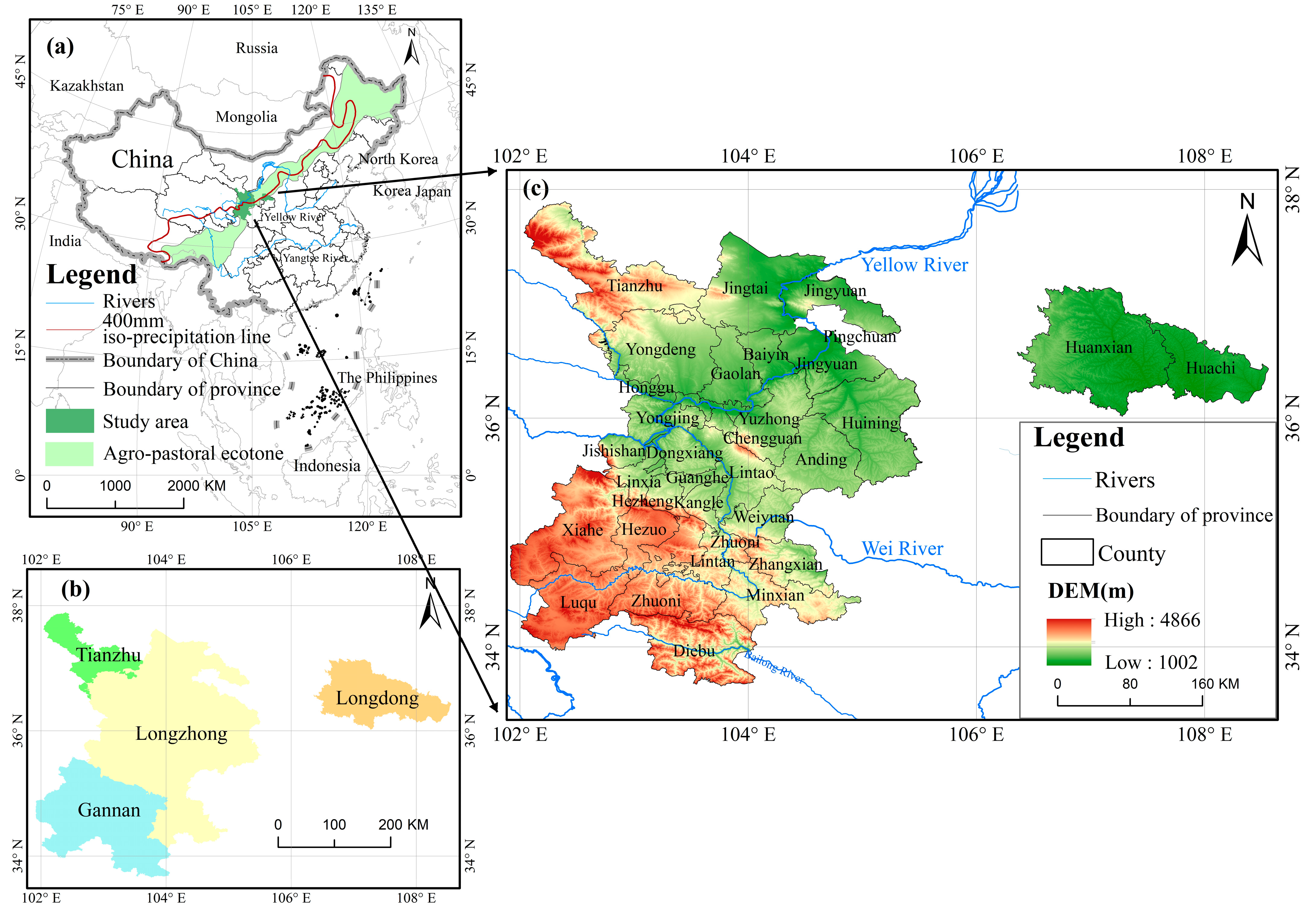
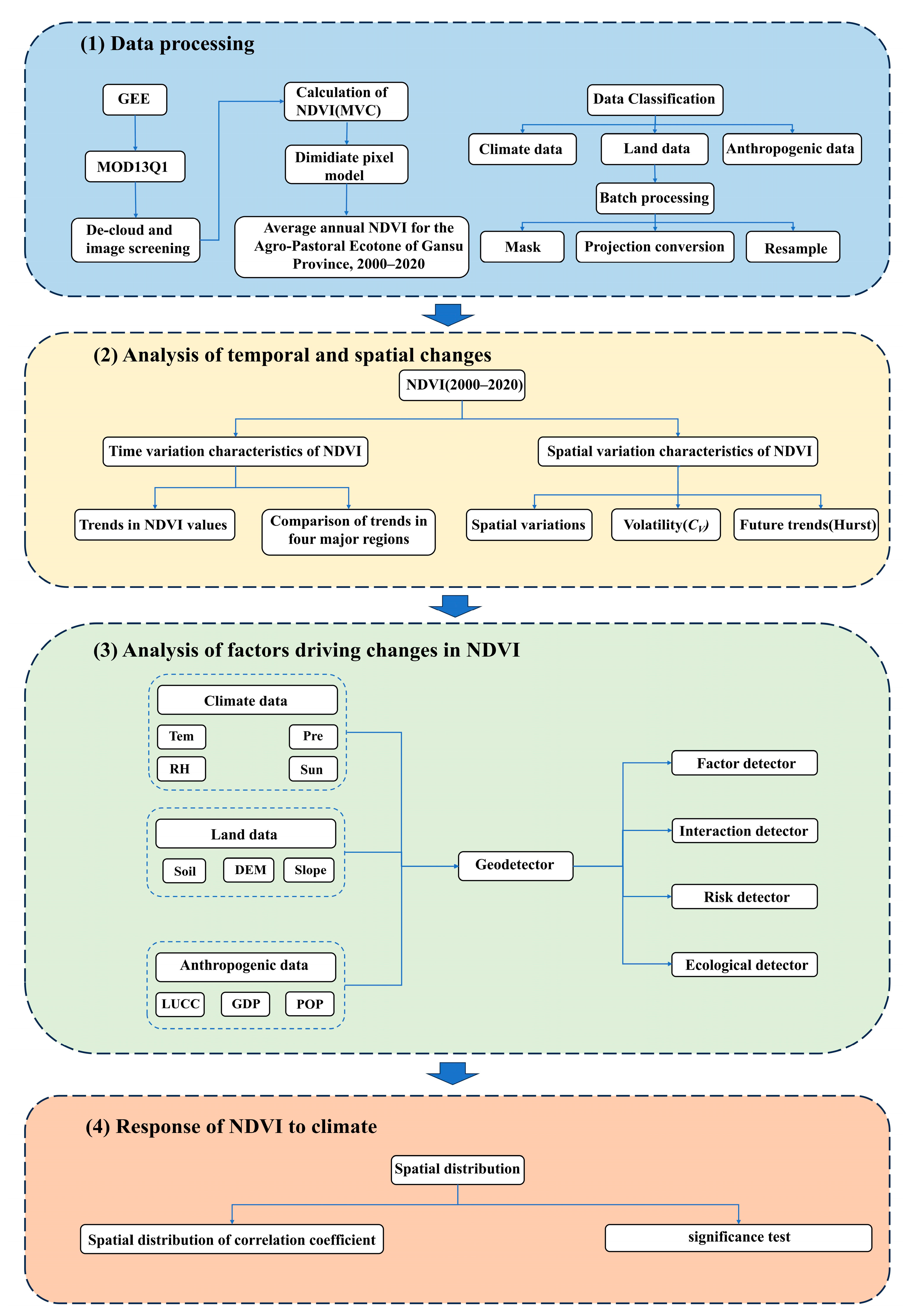
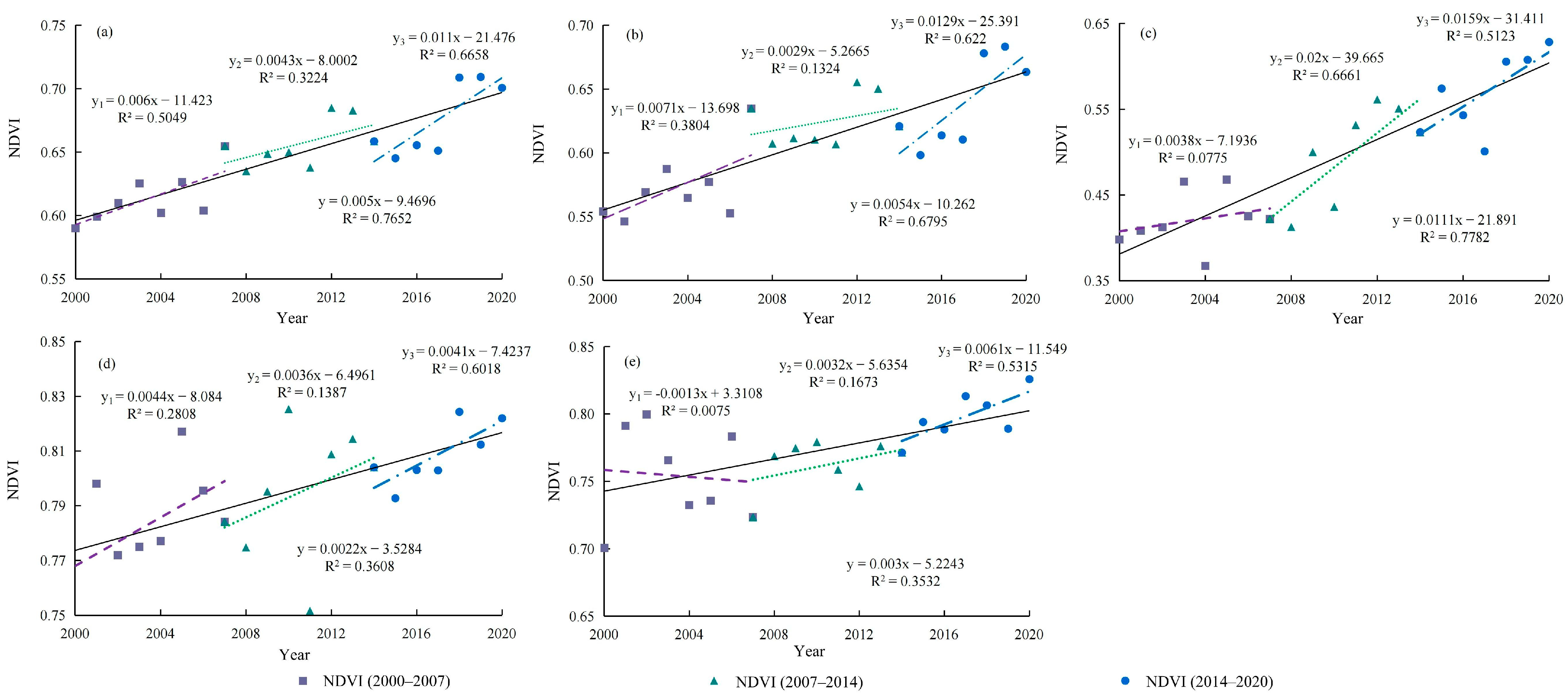
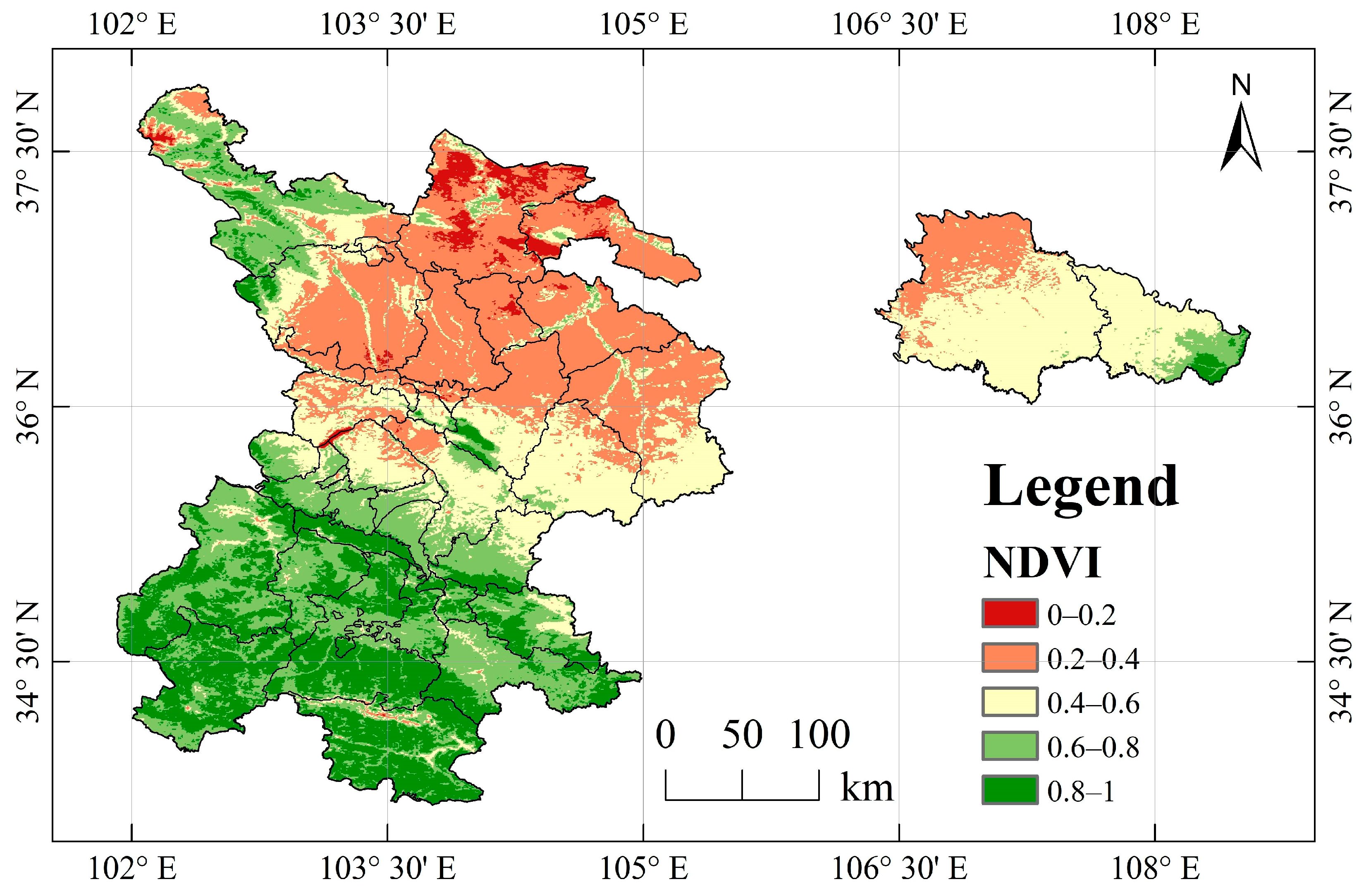

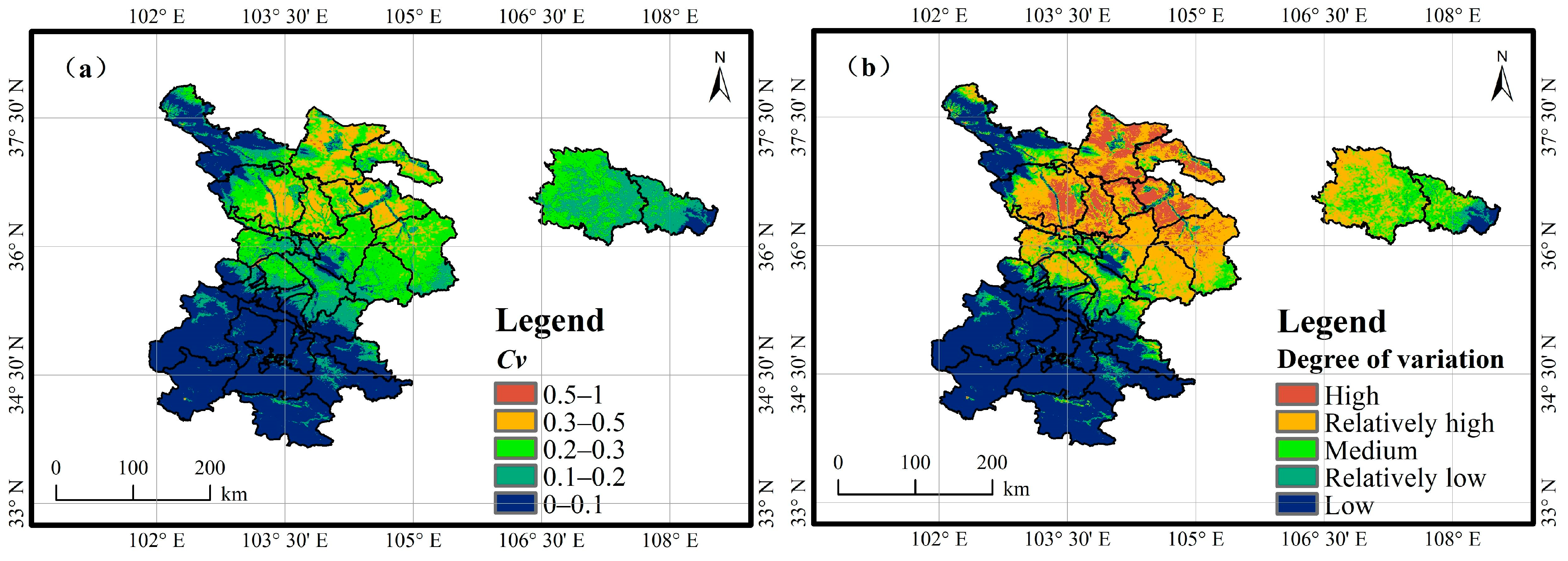
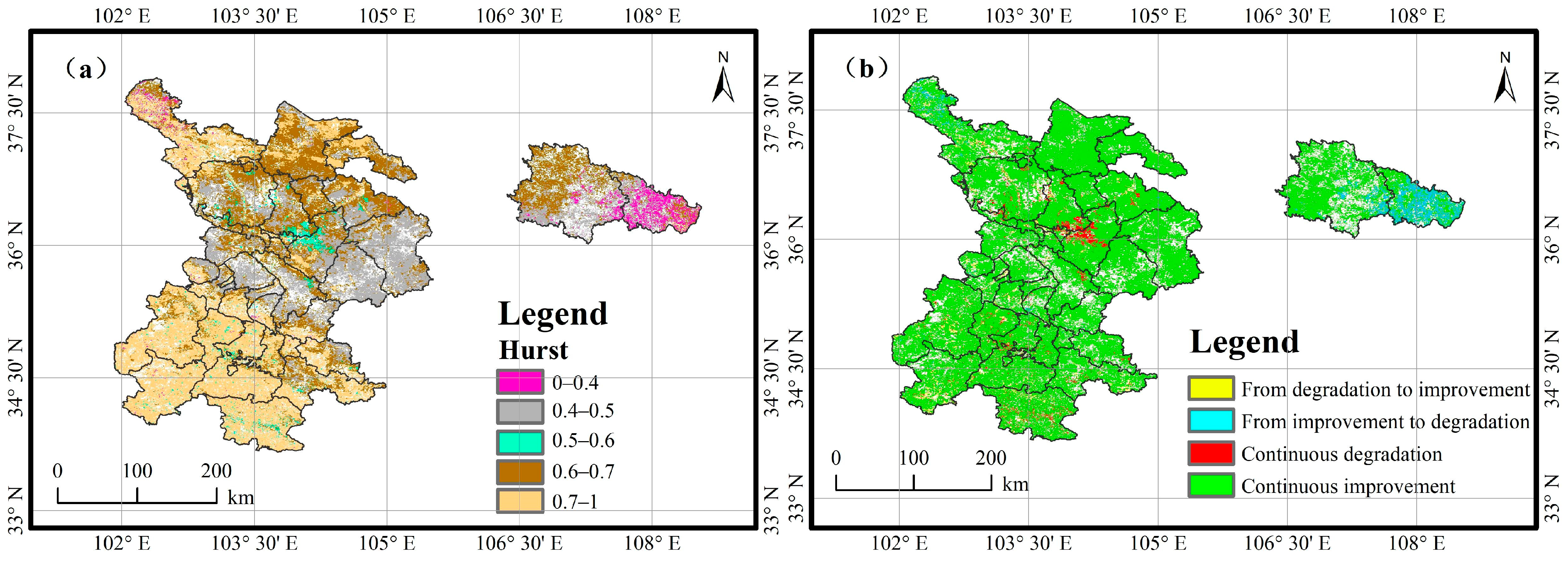
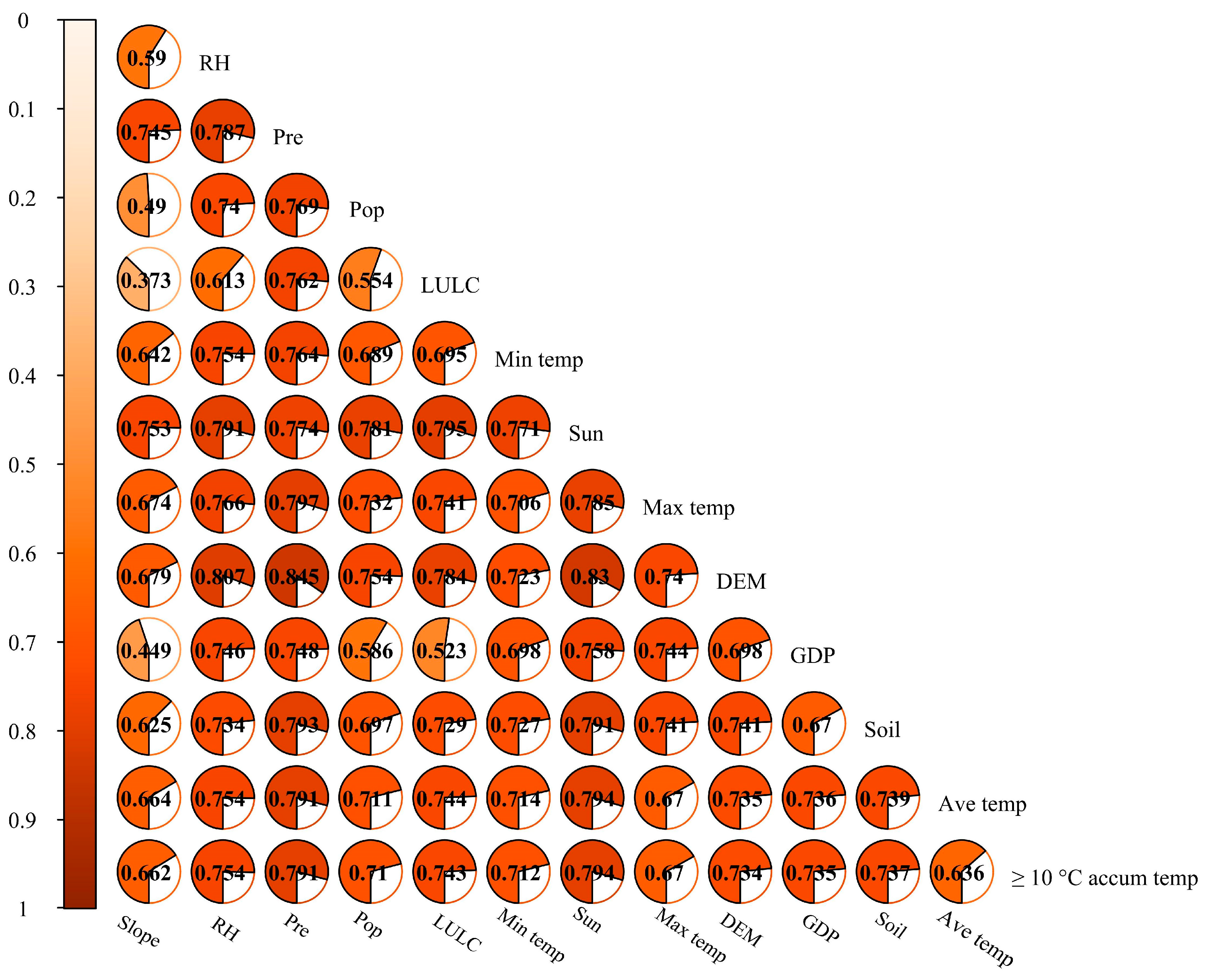
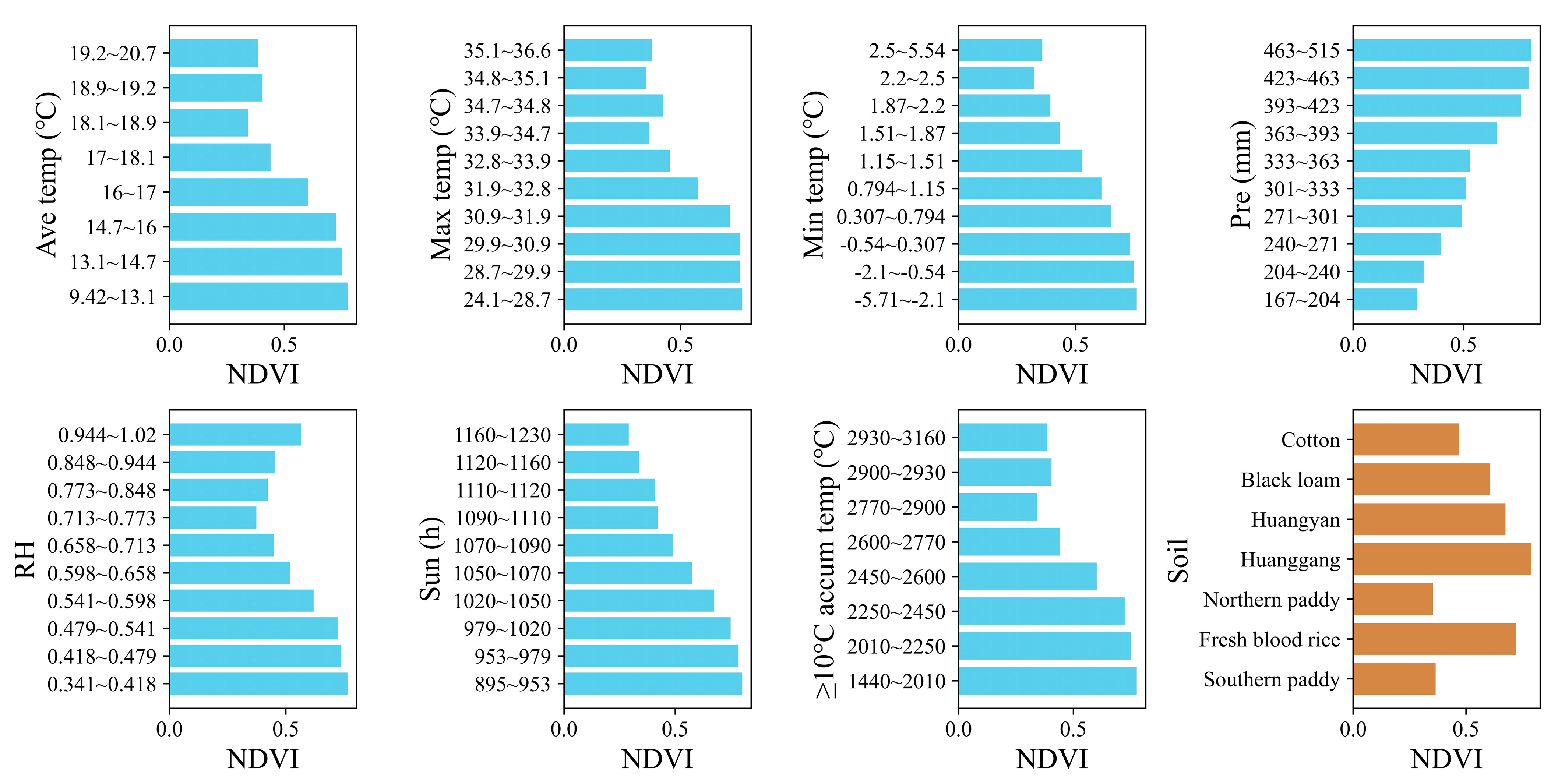

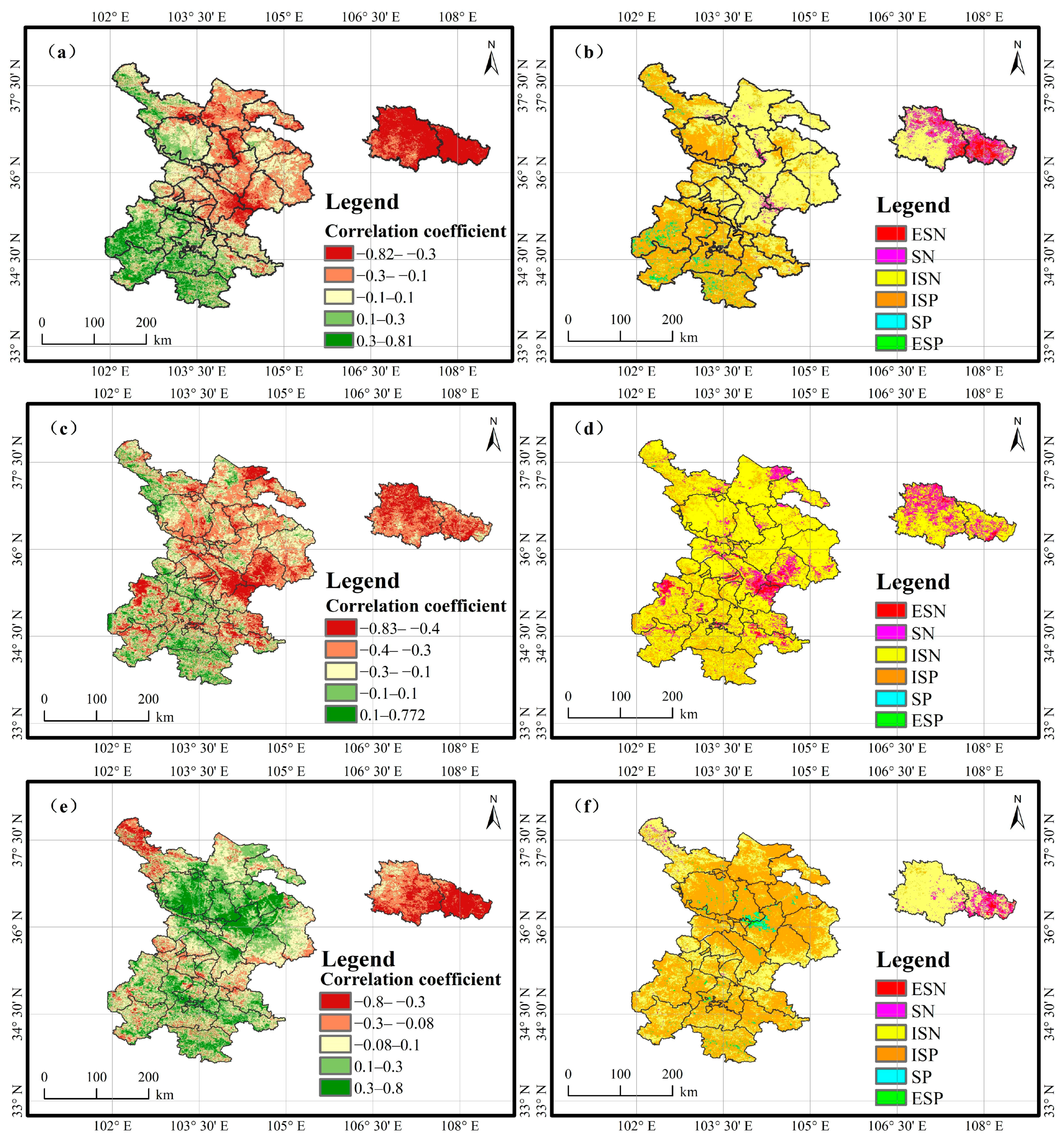
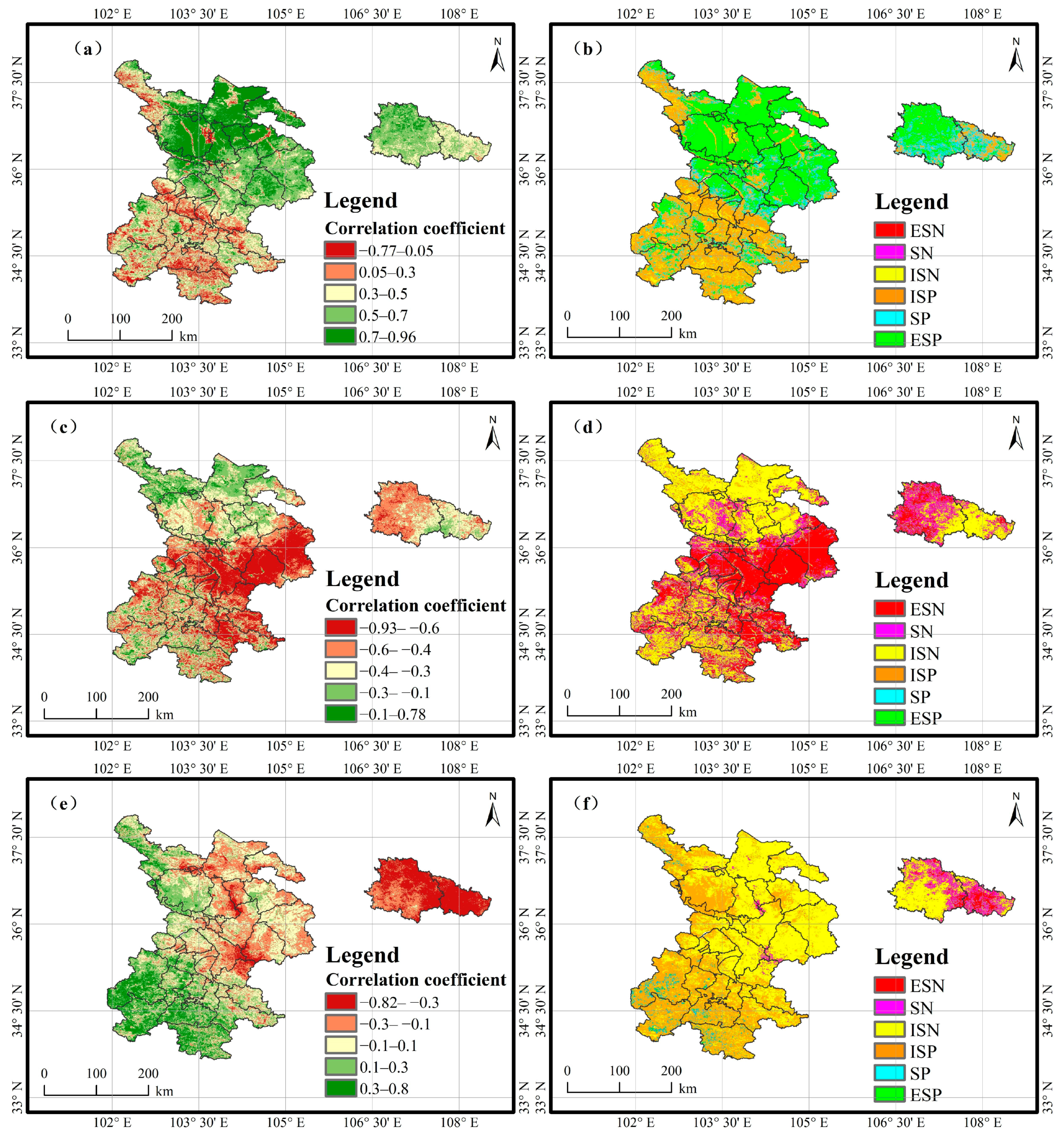
| Category | Characteristics |
|---|---|
| Climate | Annual average temperature: 0–15 °C. Annual precipitation: 200–800 mm (85% concentrated in summer). Annual sunshine duration: 1700–3300 h (north-to-south gradient). |
| Topography | Elevation: 1002–4866 mamsl (metres above mean sea level). Step-like terrain with lower elevations in the northeast and higher in the southwest. |
| Vegetation | Latitudinal zonation includes desert steppe, typical steppe, forest-steppe ecotone, and alpine meadow. Dominant crops: wheat, maize, and potato. |
| Land Use and Land Cover | Dominated by grassland, cropland, and woodland. |
| Socioeconomy | Economy relies on agriculture, animal husbandry, and eco-tourism. Average county GDP: 0.8–1.2 billion CNY. Low population density (<50 persons/km2) in high-altitude pastoral areas. |
| Data Classification | Data | Abbreviation | Data Source | Unit |
|---|---|---|---|---|
| Vegetation coverage | MOD13Q1 | NDVI | (https://ladsweb.modaps.eosdis.nasa.gov/) (250 m) | - |
| Climate factor | Average temperature | Ave temp | http://data.cma.cn | °C |
| Maximum temperature | Max temp | °C | ||
| Minimum temperature | Min temp | °C | ||
| Precipitation | Pre | mm | ||
| Relative humidity | RH | - | ||
| Sunshine hours | Sun | h | ||
| ≥10 °C accumulated temperature | ≥10 °C accum temp | °C | ||
| Land factor | Soil type | Soil | Resource and EnvironmentalScience Data Center (www.resdc.cn) (1 km) | - |
| Slope | Slope | http://www.earthdata.nasa.gov (30 m) | ° | |
| DEM | DEM | http://www.gscloud.cn/ (30 m) | m | |
| Anthropogenic factor | Population density | Pop | https://zenodo.org/ (1 km) | persons/km2 |
| LULC | LULC | https://doi.org/10.5281/zenodo.4417810 (30 m) | - | |
| GDP | GDP | https://zenodo.org/ (1 km) | million CNY |
| Significance Level | Standardized Test Statistics | Sen Trend Value | Trend Level |
|---|---|---|---|
| α = 0.01 | |Z| > 2.58 | β ≥ 0 | Extremely significant increase (ESI) |
| β < 0 | Extremely significant decrease (ESD) | ||
| α = 0.05 | 2.58 ≥ |Z| > 1.96 | β ≥ 0 | Significant increase (SI) |
| β < 0 | Significant decrease SD) | ||
| |Z| ≤ 1.96 | β ≥ 0 | Non-significant increase (ISI) | |
| β < 0 | Non-significant decrease (ISD) |
| Type of Detector | Function of Detector |
|---|---|
| Factor detector | Detecting the spatial stratification heterogeneity of variable y. The degree of explanation is measured by the value of q, with a range of [0, 1]. |
| Interaction detector | This component evaluates synergistic/antagonistic effects between covariate pairs (xi and xj), determining whether their combined influence enhanced or weakened the explanatory power of y. |
| Risk detector | Evaluation of the significance of the difference in mean values of the dependent variable y attribute within the stratified interval of determinant x. |
| Ecological detector | Exploration of the appropriate range or type of impact of different factors x on y. |
| Trend (Correlation) Coefficient | Significance Level α | NDVI Change Type | NDVI and Meteorological Factors Correlation Type |
|---|---|---|---|
| <0 | <0.01 | Extremely significant decrease | Extremely significant negative correlation (ESN) |
| 0.01~0.05 | Significant decrease | Significant negative correlation (SN) | |
| >0.05 | Non-significant decrease | Non-significant negative correlation (ISN) | |
| >0 | <0.05 | Non-significant increase | Non-significant positive correlation (ISP) |
| 0.01~0.05 | Significant increase | Significant positive correlation (SP) | |
| >0.01 | Extremely significant increase | Extremely significant positive correlation (ESP) |
| Factor | ≥10 °C Accum Temp | Ave Temp | Soil | GDP | DEM | Max Temp | Sun | Min Temp | LULC | Pop | Pre | RH | Slope |
|---|---|---|---|---|---|---|---|---|---|---|---|---|---|
| q | 0.633 | 0.635 | 0.589 | 0.327 | 0.645 | 0.634 | 0.727 | 0.578 | 0.215 | 0.382 | 0.697 | 0.452 | 0.228 |
| p | 0.000 | 0.000 | 0.000 | 0.000 | 0.000 | 0.000 | 0.000 | 0.000 | 0.000 | 0.000 | 0.000 | 0.000 | 0.000 |
| Factor | ≥10 °C Accum Temp | Ave Temp | Soil | GDP | DEM | Max Temp | Sun | Min Temp | LULC | Pop | Pre | RH | Slope |
|---|---|---|---|---|---|---|---|---|---|---|---|---|---|
| ≥10 °C accum temp | |||||||||||||
| Ave temp | N | ||||||||||||
| Soil | Y | Y | |||||||||||
| GDP | Y | Y | Y | ||||||||||
| DEM | Y | Y | Y | Y | |||||||||
| Max temp | N | N | Y | Y | Y | ||||||||
| Sun | Y | Y | Y | Y | Y | Y | |||||||
| Min temp | Y | Y | Y | Y | Y | Y | Y | ||||||
| LULC | Y | Y | Y | Y | Y | Y | Y | Y | |||||
| Pop | Y | Y | Y | Y | Y | Y | Y | Y | Y | ||||
| Pre | Y | Y | Y | Y | Y | Y | Y | Y | Y | Y | |||
| RH | Y | Y | Y | Y | Y | Y | Y | Y | Y | Y | Y | ||
| Slope | Y | Y | Y | Y | Y | Y | Y | Y | Y | Y | Y | Y | |
Disclaimer/Publisher’s Note: The statements, opinions and data contained in all publications are solely those of the individual author(s) and contributor(s) and not of MDPI and/or the editor(s). MDPI and/or the editor(s) disclaim responsibility for any injury to people or property resulting from any ideas, methods, instructions or products referred to in the content. |
© 2025 by the authors. Licensee MDPI, Basel, Switzerland. This article is an open access article distributed under the terms and conditions of the Creative Commons Attribution (CC BY) license (https://creativecommons.org/licenses/by/4.0/).
Share and Cite
Zhuo, M.; Yuan, J.; Li, J.; Li, G.; Yan, L. Spatio-Temporal Heterogeneity of Vegetation Coverage and Its Driving Mechanisms in the Agro-Pastoral Ecotone of Gansu Province: Insights from Multi-Source Remote Sensing and Geodetector. Atmosphere 2025, 16, 501. https://doi.org/10.3390/atmos16050501
Zhuo M, Yuan J, Li J, Li G, Yan L. Spatio-Temporal Heterogeneity of Vegetation Coverage and Its Driving Mechanisms in the Agro-Pastoral Ecotone of Gansu Province: Insights from Multi-Source Remote Sensing and Geodetector. Atmosphere. 2025; 16(5):501. https://doi.org/10.3390/atmos16050501
Chicago/Turabian StyleZhuo, Macao, Jianyu Yuan, Jie Li, Guang Li, and Lijuan Yan. 2025. "Spatio-Temporal Heterogeneity of Vegetation Coverage and Its Driving Mechanisms in the Agro-Pastoral Ecotone of Gansu Province: Insights from Multi-Source Remote Sensing and Geodetector" Atmosphere 16, no. 5: 501. https://doi.org/10.3390/atmos16050501
APA StyleZhuo, M., Yuan, J., Li, J., Li, G., & Yan, L. (2025). Spatio-Temporal Heterogeneity of Vegetation Coverage and Its Driving Mechanisms in the Agro-Pastoral Ecotone of Gansu Province: Insights from Multi-Source Remote Sensing and Geodetector. Atmosphere, 16(5), 501. https://doi.org/10.3390/atmos16050501





